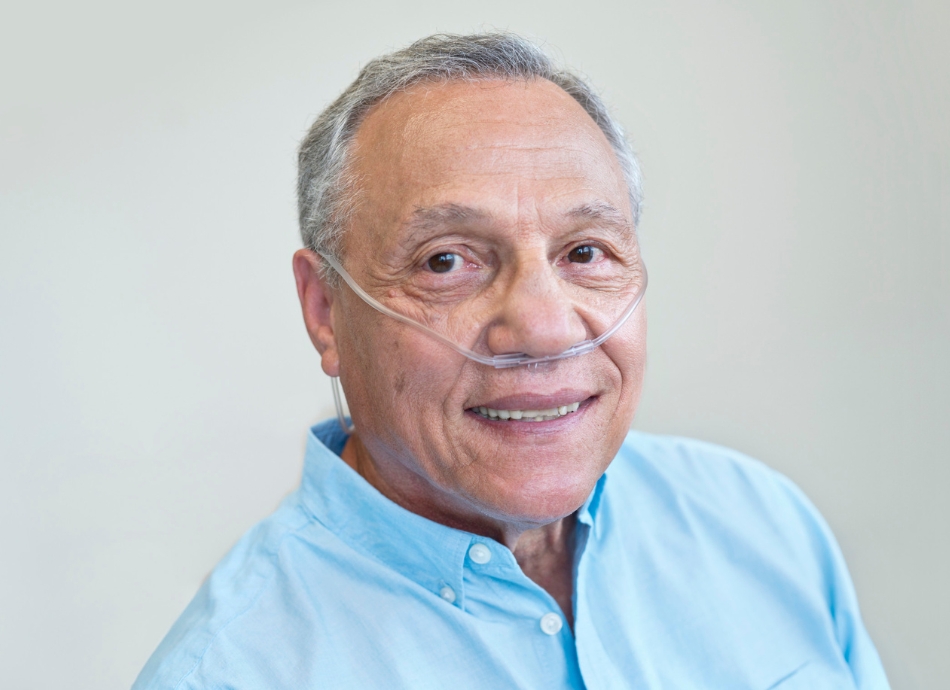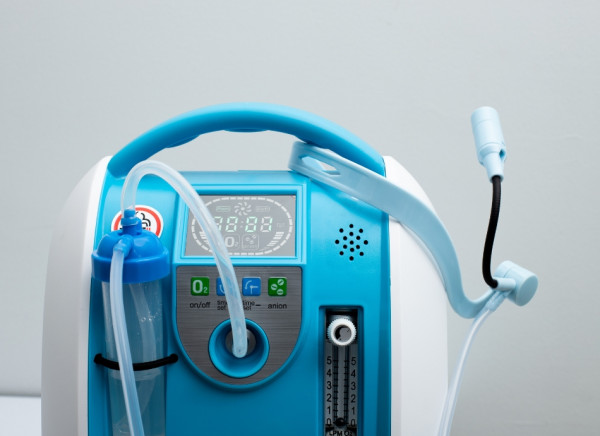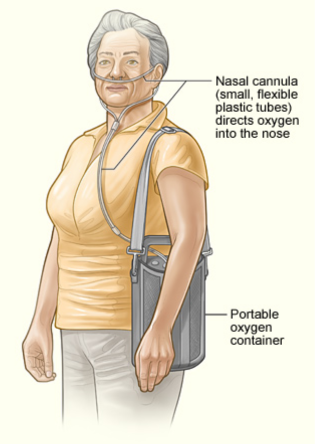Home oxygen therapy
Increasing your oxygen intake at home with an oxygen concentrator
Key points about home oxygen therapy
- Home oxygen therapy involves using a machine called an oxygen concentrator to breathe in air that has more oxygen in it than normal.
- It's used if you have health problems that stop you from getting enough oxygen from the air.
- Home oxygen therapy increases the amount of oxygen in your lungs and bloodstream.
- It helps with breathing, thinking and energy and prevents damage to your heart.

Every part of our body needs oxygen to work. Your lungs take this oxygen from the air, and it’s carried around your body in your blood. Oxygen therapy may be prescribed if you have a condition that stops your lungs from getting enough oxygen, or your heart from pumping the oxygen-carrying blood around your body. Low oxygen can make you feel breathless and tired, and your lips might look blue. If left untreated, low oxygen can damage your heart and affect your concentration and memory.
Oxygen therapy increases the amount of oxygen in your blood and can help with the symptoms of health conditions, including:
- COPD (chronic obstructive pulmonary disease) – a long-term lung condition with cough and shortness of breath, most commonly caused by smoking.
- Cystic fibrosis – an inherited condition that causes your lungs to produce a sticky mucous making breathing difficult.
- Heart failure – when your heart can't pump blood around your body properly.
- Pulmonary hypertension – high blood pressure inside the arteries to your lungs which causes damage to the right-hand side of your heart.
- Asthma that is severe and difficult to control.
- Cluster headaches.
Video: Things to know when using oxygen therapy
If your healthcare provider thinks that you might have low oxygen levels, they will refer you to a specialist who will assess whether home oxygen therapy is right for you. You will have a blood test to check your blood oxygen levels. You may also need some other tests such as a chest X-ray or ECG.
Not everyone with damaged lungs needs extra oxygen. While oxygen therapy can provide relief from breathlessness, it will only help if you're low in oxygen. If you are breathless but not low in oxygen it won’t cure your breathlessness so you and your healthcare provider will need to consider other ways of managing it. Read more about breathlessness.
You breathe in oxygen through small soft plastic tubes which fit inside your nostrils, called nasal cannulae. You can talk and eat with them on. They're attached via long plastic tubing to an oxygen concentrator. An oxygen concentrator is a machine a bit smaller than a chilly bin. It takes oxygen from the air and filters out other gases to concentrate the oxygen. This concentrated oxygen is what you then breathe in. It doesn’t affect the quality of the air for others around you.
Instead of nasal cannulae some people use a face mask.
The concentrator runs on electricity and can be noisy. The tubing between the nasal cannulae and the concentrator is very long. The concentrator can be stored in a separate space, away from your living and sleeping areas, but you still have the freedom to move around your home. An oxygen concentrator can be moved, but it's too heavy to easily carry around with you.

Image credit: Canva
If you meet the eligibility criteria, home oxygen therapy is a funded service. You will be reviewed regularly to see if you still need the therapy and whether it's working for you.
If you need oxygen to keep working or studying, discuss portable options with your oxygen service provider. Funding for these varies.

Image credit: National Heart Lung and Blood Institute (NIH), Public domain, via Wikimedia Commons
Home oxygen therapy works best if it's used 24 hours a day, or at least 18 hours each day. It’s usually used overnight as your oxygen levels can drop at night. It may also help you sleep better.
You’ll be taught how to use the oxygen concentrator and how many hours you need to use it for.
Not necessarily. Some people who start oxygen therapy will have to use it permanently, but you may only have to use it for a short time.
Oxygen is a medicine prescribed for you so you shouldn’t start, stop or adjust the way you use it without talking with your healthcare provider. Too much oxygen can make you breathe less and get sicker.
Home oxygen therapy can mean you have fewer hospital admissions or spend less time in hospital. Less strain on your heart can lengthen your life. When your oxygen levels are restored, you should find you:
- can think more clearly
- have more energy
- can exercise more easily
- feel more positive
- feel less tired.
Oxygen is highly flammable. Nobody can smoke or vape around your oxygen equipment.
If you smoke you won’t be eligible for home oxygen therapy due to the fire risk and because you may not benefit from it. If people in your household smoke they’ll need to do this outside.
You also mustn’t be near any open flame (eg, some forms of gas heating) when you are wearing your oxygen. Don’t use it in the kitchen, around gas or electrical cookers.
The tubing running from the concentrator can be a tripping hazard, so you need to be aware of this.
Oxygen(external link) Lung Foundation, Australia
Use of oxygen therapy in COPD(external link) Patient Info, UK, 2020
Brochures
Long term oxygen therapy(external link) Asthma Respiratory Foundation NZ
Oxygen therapy – patient information sheet(external link) American Thoracic Society
Apps
References
- Oxygen therapy – patient information sheet(external link) American Thoracic Society
- Home oxygen therapy(external link) Counties Manukau, HealthPoint NZ
- Home oxygen treatment(external link) NHS Choices, UK
- Living with COPD(external link) Asthma and Respiratory Foundation NZ
- Long-term oxygen therapy(external link) Asthma and Respiratory Foundation, NZ
- McDonald CF. Home oxygen therapy(external link) Australian Prescriber 2022;45:21-24
- McDonald CF, Whyte K, Jenkins S, et al. Clinical practice guideline on adult domiciliary oxygen therapy – executive summary from the Thoracic Society of Australia and New Zealand(external link) Respirology 2016;21(1):76-8
Beasley R, Chien J, Douglas J, et al. Thoracic Society of Australia and New Zealand guidelines for acute oxygen use in adults – ‘swimming between the flags'(external link) Respirology 2015;20(8):1182–1191
Thoracic Society of Australia and New Zealand guidelines video(external link) Agency for Clinical Innovation, 2015
Use of oxygen therapy in COPD(external link) Patient Info, UK, 2020
Prescribing oxygen(external link) Patient Info, UK, 2020
Apps
Credits: Healthify editorial team. Healthify is brought to you by Health Navigator Charitable Trust.
Reviewed by: Alan Shaw, Respiratory Clinical Nurse Specialist
Last reviewed:





